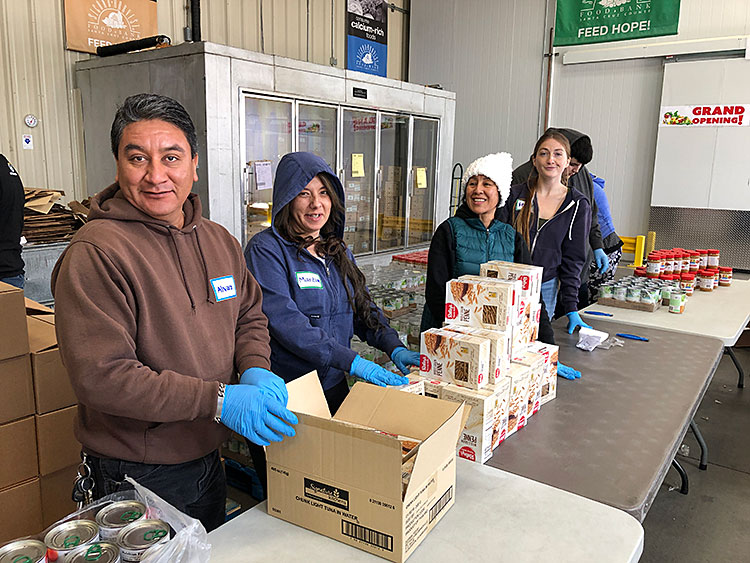You’ve likely heard of Second Harvest Food Bank of Santa Cruz County. But what’s a food bank and how does ours work?
There’s one in every county. Ours, the first in California, began in 1972 and is the second in the nation.
The name “Second Harvest” is used by many food banks. Our food bank is one of the founding members of the Feeding American Network.
How is the Food Bank Sustained?
As a non-profit, 501(c)(3) corporation, Second Harvest, through an active development program, receives private donations, corporate gifts, foundation, local and national business, and government grants.

Volunteers prepare food packages in early March before regulations. From left: Alvaro Ceja, Maritza Ruiz, Maribel Garcia and Heather Turley.
Extensive relationships with farmers, retailers, and food bank networks sources over 8 million pounds of food in typical years. Much of it donated by farms, grocery stores, food manufacturers and distributors.
“We’re blessed being in an agricultural area and receiving produce donations from growers and food producers like Lakeside Organic Gardens, Driscoll’s, Field Fresh Farms and so many others,” explains Brendan Miele, COO at Second Harvest.
Second Harvest buys food in the wholesale market as well. Because of these relationships, it can provide four meals of healthy food for a dollar. Donating cash to the food bank, rather than retail food purchases, is a more effective way of addressing hunger. Examples: A jar of peanut butter costs about $3 at retail. The food bank pays just over a dollar. Apples that cost $1 a pound at the store are typically 12 cents a pound for the food bank.
What’s Special About Our Food Bank?
Santa Cruz is a small but highly diverse county in businesses and population. The two key industries are hospitality and agriculture.
Willy Elliott-McCrea (right) receives a check for Second Harvest Food Bank from Twin Lakes Church pastor Rene Schlaepfer.
Many Silicon Valley tech workers live here. That industry has footholds and growing businesses as well. And we have a world-class university. We grow, pack and ship an enormous variety and amount of food. Multiple crops per year are possible.
Organic agriculture is well-established. These factors all have effects on food demand and the ability to supply those in need. Perhaps most valuable is the unsung army of volunteers staffing all the locations where food is distributed.
How Does Food Get to People?
Think of the hunger-fighting system, the bank and its partner agencies, as a hub of a wheel. The food bank at the hub serves myriad organizations including churches, schools, pantries and other nonprofits.
You’ve likely seen our trucks delivering food to local pickup locations as well as bringing food from beyond the county.
Partner agencies also collect food from the food bank. The system works on a just-in-time schedule making food available.
Who Receives the Food?
One-in-four children and one-in-five adults in our county face hunger. Hunger is an unfortunately invisible problem.
But the food bank and its partners typically reach 55,000 people monthly. That includes children, seniors, veterans, homeless, working poor and those needing some help during tough times. Since the onslaught of the Covid-19 pandemic, that number has nearly doubled.
How is Second Harvest Navigating the Pandemic/Wildfire Crisis?
The food bank has been stretched due to cascading challenges. Volunteer staff, normally doing packing and handling, can’t volunteer due to limited space.
The California National Guard, with government assistance, has thankfully stepped in. Temporary workers, replacing volunteers have been hired.
Truck drivers are in short supply since package delivery services are demanding their skills. And partner agencies have been unable to visit the food bank due to Covid restrictions.
The whole food-supply chain was disrupted but is stabilizing. Shortages of some items still occur. Availability of packaging supplies for transporting food was a problem.
Second Harvest now has several refrigerated trailers handling vastly increased supply volumes. A second warehouse was added.
The enormous spike in food demand is being met. You’re probably aware of news about the weekly, mass food distributions at the county fairgrounds in Watsonville and Santa Cruz Beach Boardwalk parking lots.
Most heartening are the people of our county demonstrating generosity, which makes ends meet. Donations large, medium and small are arriving to help meet this challenge.
The county is coming together and winning this fight. We have hundreds of “Hunger Heroes” to be thankful for. That’s how your food bank works!
••
Photos by Jennifer Welling courtesy of Second Harvest Food Bank